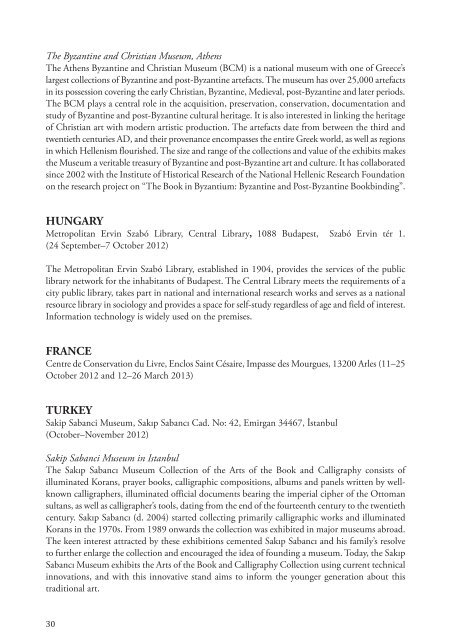Byzantium and the Art of Binding - STUDITE
Byzantium and the Art of Binding - STUDITE
Byzantium and the Art of Binding - STUDITE
You also want an ePaper? Increase the reach of your titles
YUMPU automatically turns print PDFs into web optimized ePapers that Google loves.
The Byzantine <strong>and</strong> Christian Museum, A<strong>the</strong>ns<br />
The A<strong>the</strong>ns Byzantine <strong>and</strong> Christian Museum (BCM) is a national museum with one <strong>of</strong> Greece’s<br />
largest collections <strong>of</strong> Byzantine <strong>and</strong> post-Byzantine artefacts. The museum has over 25,000 artefacts<br />
in its possession covering <strong>the</strong> early Christian, Byzantine, Medieval, post-Byzantine <strong>and</strong> later periods.<br />
The BCM plays a central role in <strong>the</strong> acquisition, preservation, conservation, documentation <strong>and</strong><br />
study <strong>of</strong> Byzantine <strong>and</strong> post-Byzantine cultural heritage. It is also interested in linking <strong>the</strong> heritage<br />
<strong>of</strong> Christian art with modern artistic production. The artefacts date from between <strong>the</strong> third <strong>and</strong><br />
twentieth centuries AD, <strong>and</strong> <strong>the</strong>ir provenance encompasses <strong>the</strong> entire Greek world, as well as regions<br />
in which Hellenism flourished. The size <strong>and</strong> range <strong>of</strong> <strong>the</strong> collections <strong>and</strong> value <strong>of</strong> <strong>the</strong> exhibits makes<br />
<strong>the</strong> Museum a veritable treasury <strong>of</strong> Byzantine <strong>and</strong> post-Byzantine art <strong>and</strong> culture. It has collaborated<br />
since 2002 with <strong>the</strong> Institute <strong>of</strong> Historical Research <strong>of</strong> <strong>the</strong> National Hellenic Research Foundation<br />
on <strong>the</strong> research project on “The Book in <strong>Byzantium</strong>: Byzantine <strong>and</strong> Post-Byzantine Bookbinding”.<br />
hUNGArY<br />
Metropolitan Ervin Szabó Library, Central Library, 1088 Budapest, Szabó Ervin tér 1.<br />
(24 September–7 October 2012)<br />
The Metropolitan Ervin Szabó Library, established in 1904, provides <strong>the</strong> services <strong>of</strong> <strong>the</strong> public<br />
library network for <strong>the</strong> inhabitants <strong>of</strong> Budapest. The Central Library meets <strong>the</strong> requirements <strong>of</strong> a<br />
city public library, takes part in national <strong>and</strong> international research works <strong>and</strong> serves as a national<br />
resource library in sociology <strong>and</strong> provides a space for self-study regardless <strong>of</strong> age <strong>and</strong> field <strong>of</strong> interest.<br />
Information technology is widely used on <strong>the</strong> premises.<br />
FrANce<br />
Centre de Conservation du Livre, Enclos Saint Césaire, Impasse des Mourgues, 13200 Arles (11–25<br />
October 2012 <strong>and</strong> 12–26 March 2013)<br />
tUrkeY<br />
Sakip Sabanci Museum, Sakıp Sabancı Cad. No: 42, Emirgan 34467, İstanbul<br />
(October–November 2012)<br />
Sakip Sabanci Museum in Istanbul<br />
The Sakıp Sabancı Museum Collection <strong>of</strong> <strong>the</strong> <strong>Art</strong>s <strong>of</strong> <strong>the</strong> Book <strong>and</strong> Calligraphy consists <strong>of</strong><br />
illuminated Korans, prayer books, calligraphic compositions, albums <strong>and</strong> panels written by wellknown<br />
calligraphers, illuminated <strong>of</strong>ficial documents bearing <strong>the</strong> imperial cipher <strong>of</strong> <strong>the</strong> Ottoman<br />
sultans, as well as calligrapher’s tools, dating from <strong>the</strong> end <strong>of</strong> <strong>the</strong> fourteenth century to <strong>the</strong> twentieth<br />
century. Sakıp Sabancı (d. 2004) started collecting primarily calligraphic works <strong>and</strong> illuminated<br />
Korans in <strong>the</strong> 1970s. From 1989 onwards <strong>the</strong> collection was exhibited in major museums abroad.<br />
The keen interest attracted by <strong>the</strong>se exhibitions cemented Sakıp Sabancı <strong>and</strong> his family’s resolve<br />
to fur<strong>the</strong>r enlarge <strong>the</strong> collection <strong>and</strong> encouraged <strong>the</strong> idea <strong>of</strong> founding a museum. Today, <strong>the</strong> Sakıp<br />
Sabancı Museum exhibits <strong>the</strong> <strong>Art</strong>s <strong>of</strong> <strong>the</strong> Book <strong>and</strong> Calligraphy Collection using current technical<br />
innovations, <strong>and</strong> with this innovative st<strong>and</strong> aims to inform <strong>the</strong> younger generation about this<br />
traditional art.<br />
30<br />
<strong>STUDITE</strong>-CAT-<strong>Byzantium</strong>-<strong>Art</strong>-Of-<strong>Binding</strong>s.indd 30 05/09/2012 10:54


